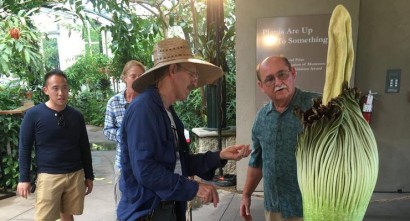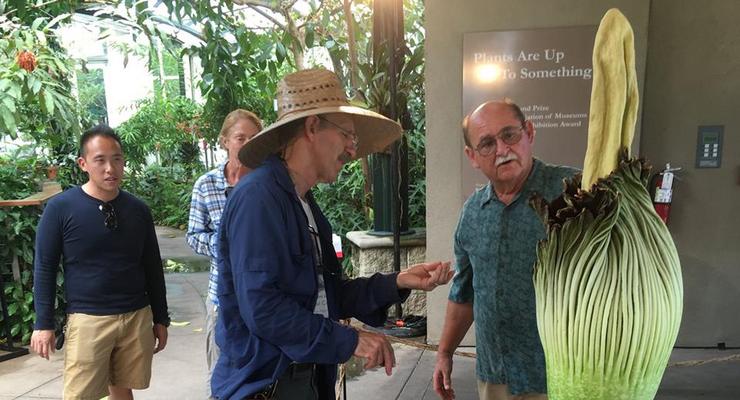A Corpse Flower plant named “L’il Stinker” at the Huntington Library, Art Collections and Botanical Gardens in San Marino disappointed fans failed to bloom as expected by Wednesday, and now botanists are trying to find out why the plant didn’t mature.
The staff at the Huntington had declared a “bloom watch” on the plant earlier this month, inviting patrons to come over and join them as they awaited the Li’l Stinker’s first attempt to flower.

When Corpse Flowers blossom, the plant (scientific name Amorphophallus titanium), native to the tropical rainforests of Sumatra, releases a rotten stench that’s meant to attract pollinating insects – those that feed on dead animals or lay their eggs in rotting meat.
Analyses of the chemicals released by other Corpse Flowers show the stench include chemicals exuded from rotting fish, Limburger cheese, old sweaty socks, rotting onions and cabbage, and human feces, according to the American Chemical Society.
On Wednesday, Huntington officials announced the plant apparently would in fact not bloom, disappointing the Corpse Flower’s many fans.
To start the process of finding out the cause, botanists performed a live (on Facebook) dissection of the plant inside the Rose Hills Foundation Conservatory at the Huntington, first cutting off and separating the spathe (the sheath that protects the inner parts of the flower) from the spadix (the central spike in the titan arum plant), and then dissecting the spadix itself.
“We decided to take the opportunity to open up to the public where we can actually do a cross-section, a dissection of the flower, and have it become an educational exhibit where people can discover the internal workings of this inflorescence,” Brandon Tam, a botanist at the Huntington gardens, said.
“Most people, when looking at this plant, are unable to see the inner workings, the bottom of the flower, where all the action is happening, so we were able to dissect it and people just loved the opportunity because this is something – a rare event that not many people get to see.”
The botanists said they still don’t know the specific cause of L’il Stinker’s failure to bloom, but they speculate the plant may not have had enough energy to produce a bloom, and that the plant “decided” to halt the process in order to conserve resources for a future attempt at flowering.
“One reason why we think it aborted was because this is what we call a first-time bloomer, even though it’s 16 years old, and since this is its first time blooming, it thought that it had enough energy to produce a flower,” Tam said. “In the end, it decided, ‘well, let me abort the flower and return that energy back into the corm to work in the future.”
Tam added the plant may have better hopes of producing a bigger, better future flower that can actually open up for people to see.
In the presentation covered live on Facebook, John Trager, Curator for the Desert Garden and Desert Collections at the Huntington, said the plant also failed to give out what was expected to be a strong aroma of decaying matter, although they did detect some unpleasant smell close to the plant itself.
Staff also took swabs of the spadix’s soft pulp to examine in the lab and help in the investigation.
Even with the upper parts of the plant dissected, this particular plant continues to grow from a corm – a rounded storage organ of the plant that’s underground.
“The corm is basically like a potato that’s underground, and this corm is actually the housing unit where all the energy is stored,” Tam said. “And every year he comes out either as a leaf or the flower, but mostly it comes out a leaf because a leaf that comes out to build up the energy and to put photosynthesis into play, and to gather the energy to produce a flower every four to six years.”
The titan arum that was dissected Tuesday is just one of several plants that are in the care of the Huntington. Titan arums are native to the equatorial rainforests of Sumatra, but other plants have been grown elsewhere, mostly in botanical gardens in the U.S., Europe and other parts of the world.
The most recent bloom by a titan arum at the Huntington was on August 23, 2014, its towering inflorescence reaching up to five feet six inches before it opened and released its foul-smelling odors, attracting pollinating insects, and attracting a good number of visitors, too.
It was only the fifth time a Corpse Flower bloomed at the Huntington. The first was in 1999.

















